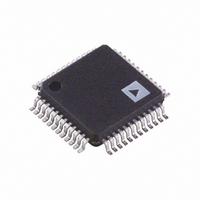ADM1062ASUZ Analog Devices Inc, ADM1062ASUZ Datasheet - Page 16

ADM1062ASUZ
Manufacturer Part Number
ADM1062ASUZ
Description
IC SUPERVISOR/SEQUENCER 48-TQFP
Manufacturer
Analog Devices Inc
Type
Sequencerr
Datasheet
1.EVAL-ADM1062LFEB.pdf
(36 pages)
Specifications of ADM1062ASUZ
Number Of Voltages Monitored
10
Output
Programmable
Voltage - Threshold
Adjustable/Selectable
Operating Temperature
-40°C ~ 85°C
Mounting Type
Surface Mount
Package / Case
48-TQFP, 48-VQFP
For Use With
EVAL-ADM1062TQEBZ - BOARD EVALUATION FOR ADM1062TQEVAL-ADM1062LFEBZ - BOARD EVALUATION FOR ADM1062LF
Lead Free Status / RoHS Status
Lead free / RoHS Compliant
Reset
-
Reset Timeout
-
Available stocks
Company
Part Number
Manufacturer
Quantity
Price
Company:
Part Number:
ADM1062ASUZ
Manufacturer:
Analog Devices Inc
Quantity:
10 000
Part Number:
ADM1062ASUZ
Manufacturer:
ADI/亚德诺
Quantity:
20 000
Company:
Part Number:
ADM1062ASUZ-REEL7
Manufacturer:
Analog Devices Inc
Quantity:
10 000
ADM1062
OUTPUTS
SUPPLY SEQUENCING THROUGH
CONFIGURABLE OUTPUT DRIVERS
Supply sequencing is achieved with the ADM1062 using the
programmable driver outputs (PDOs) on the device as control
signals for supplies. The output drivers can be used as logic
enables or as FET drivers.
The sequence in which the PDOs are asserted (and, therefore,
the supplies are turned on) is controlled by the sequencing engine
(SE). The SE determines what action is taken with the PDOs,
based on the condition of the ADM1062 inputs. Therefore, the
PDOs can be set up to assert when the SFDs are in tolerance,
the correct input signals are received on the VXx digital pins,
no warnings are received from any of the inputs of the device,
and at other times. The PDOs can be used for a variety of func-
tions. The primary function is to provide enable signals for LDOs
or dc-to-dc converters that generate supplies locally on a board.
The PDOs can also be used to provide a PWRGD signal, when
all the SFDs are in tolerance, or a RESET output if one of the
SFDs goes out of specification (this can be used as a status signal
for a DSP, FPGA, or other microcontroller).
The PDOs can be programmed to pull up to a number of differ-
ent options. The outputs can be programmed as follows:
•
•
•
•
•
•
•
The last option (available only on PDO1 to PDO6) allows the
user to directly drive a voltage high enough to fully enhance an
external N-FET, which is used to isolate, for example, a card-
side voltage from a backplane supply (a PDO can sustain greater
than 10.5 V into a 1 μA load). The pull-down switches can also
be used to drive status LEDs directly.
The data driving each of the PDOs can come from one of three
sources. The source can be enabled in the PDOxCFG configuration
Open-drain (allowing the user to connect an external
pull-up resistor).
Open-drain with weak pull-up to V
Open-drain with strong pull-up to V
Open-drain with weak pull-up to VPx.
Open-drain with strong pull-up to VPx.
Strong pull-down to GND.
Internally charge-pumped high drive (12 V, PDO1 to
PDO6 only).
SMBus DATA
CLK DATA
SE DATA
CFG4 CFG5 CFG6
DD
DD
.
.
Figure 25. Programmable Driver Output
Rev. B | Page 16 of 36
SEL
VP1
register (see the AN-698 Application Note at
details).
The data sources are as follows:
•
•
•
DEFAULT OUTPUT CONFIGURATION
All of the internal registers in an unprogrammed ADM1062
device from the factory are set to 0. Because of this, the PDOx pins
are pulled to GND by a weak (20 kΩ) on-chip pull-down resistor.
As the input supply to the ADM1062 ramps up on VPx or VH,
all the PDOx pins behave as follows:
Input supply = 0 V to 1.2 V. The PDOs are high impedance.
Input supply = 1.2 V to 2.7 V. The PDOs are pulled to GND
Supply > 2.7 V. Factory-programmed devices continue to pull
The internal pull-down can be overdriven with an external pull-up
of suitable value tied from the PDOx pin to the required pull-up
voltage. The 20 kΩ resistor must be accounted for in calculating
a suitable value. For example, if PDOx must be pulled up to 3.3 V,
and 5 V is available as an external supply, the pull-up resistor value
is given by
Therefore,
Output from the SE.
Directly from the SMBus. A PDO can be configured so that
the SMBus has direct control over it. This enables software
control of the PDOs. Therefore, a microcontroller can be used
to initiate a software power-up/power-down sequence.
On-chip clock. A 100 kHz clock is generated on the device.
This clock can be made available on any of the PDOs. It
can be used, for example, to clock an external device such
as an LED.
by a weak (20 kΩ) on-chip pull-down resistor.
all PDOs to GND by a weak (20 kΩ) on-chip pull-down
resistor. Programmed devices download current EEPROM
configuration data, and the programmed setup is latched. The
PDO then goes to the state demanded by the configuration.
This provides a known condition for the PDOs during
power-up.
3.3 V = 5 V × 20 kΩ/(R
R
UP
VP4
= (100 kΩ − 66 kΩ)/3.3 V = 10 kΩ
V
DD
VFET (PDO1 TO PDO6 ONLY)
UP
+ 20 kΩ)
PDO
www.analog.com
for














